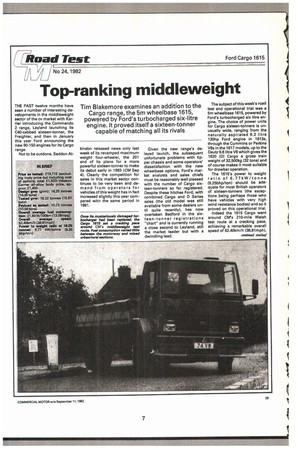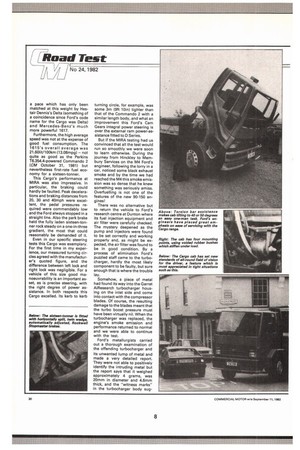Top-ranking middleweight
Page 123

Page 124

Page 125

If you've noticed an error in this article please click here to report it so we can fix it.
Tim Blakemore examines an addition to the Cargo range, the 5m wheelbase 1615, powered by Ford's turbocharged six-litre engine. It proved itself a sixteen-ton ner capable of matching all its rivals
THE PAST twelve months have seen a number of interesting developments in the middleweight sector of the cv market with Karrier introducing the Commando 2 range, Leyland launching its C40-cabbed sixteen-tanner, the Freighter, and then in January this year Ford announcing the new 90-150 engines for its Cargo range.
Not to be outdone, Seddon At
kinsbn released news only last week of its revamped maximum weight four-wheeler, the 201 and of its plans for a more powerful sixteen-tonner to make its debut early in 1983 (CM Sep 4). Clearly the competition for sales in this market sector continues to be very keen and demand from operators for vehicles of this weight has in fact increased slightly this year compared with the same period in 1981.
Given the new range's delayed launch, the subsequent unfortunate problems with tipper chassis and some operators' dissatisfaction with the new wheelbase options, Ford's market analysts and sales chiefs must be reasonably well pleased with the number of Cargo sixteen-tonners so far registered. Despite these hitches Ford; with combined Cargo and D Series sales (the old model was still available from some dealers until quite recently), has now overtaken Bedford in the sixteen-tonner registrations "chart" and is currently running a close second to Leyland, still the market leader but with a dwindling lead. The subject of this week's road test and operational trial was a 5m wheelbase 1615, powered by Ford's turbocharged six litre engine. The choice of power units for Cargo sixteen-tonners is unusually wide, ranging from the naturally aspirated 6.2 litre 130hp Ford engine in 1613s, through the Cummins or Perkins V8s in the 1617 models, up to the Deutz 9.6 litre V6 which gives the 1620 ID) Cargo a gross train weight of 32,500kg (32 tons) and of course makes it most suitable for drawbar operation.
The 1615's power to weight ratio of 6.77 kW/tonne (9.25bhp/ton) should be adequate for most British operators of sixteen-tonners (the exceptions being perhaps those who have vehicles with very high wind resistance bodies) and so it proved on this operational trial.
Indeed the 1615 Cargo went around CM's 210-mile Welsh test route at a cracking pace, achieving a remarkable overall speed of 62.40km/h (38.81m ph
a pace which has only been matched at this weight by Hestair Dennis's Delta (something of a coincidence since Ford's code name for the Cargo was Delta) and Mercedes-Benz's much more powerful 1617.
Furthermore, the high average speed was not at the expense of good fuel consumption. The 1615's overall average was 21.601it/100km (13.08mpg) — not quite as good as the Perkins T6.354.4-powered Commando 2 (CM October 31, 1981) but nevertheless first-rate fuel economy for a sixteen-tonner.
This Cargo's performance at MIRA was also impressive. In particular, the braking could hardly be faulted. Peak decelerations and braking distances from 20, 30 and 40mph were excellent, the pedal pressures required were commendably low and the Ford always stopped in a straight line. Also the park brake held the fully laden sixteen-tonner rock steady on a one-in-three gradient, the most that could reasonably be demanded of it.
Even in our specific steering tests this Cargo was exemplary. For the first time in my experience, our measured turning circles agreed with the manufacturer's quoted figure, and the difference between left lock and right lock was negligible. For a vehicle of this size good manoeuvrability is an important asset, as is precise steering, with the right degree of power assistance. In both respects this Cargo excelled. Its kerb to kerb turning circle, for example, was some 3m (9ft 10in) tighter than that of the Commando 2 with a similar length body, and what an improvement this Ford's Cam Gears integral power steering is over the external ram power-assistance fitted to D Series.
But if the MIRA testing had us convinced that all the test would run so smoothly we were soon to learn otherwise. During the journey from Hinckley to Membury Services on the M4 Ford's engineer, following the lorry in a car, noticed some black exhaust smoke and by the time we had reached the M4 this smoke emission was so dense that he knew something was seriously amiss. Overfuelling is not one of the features of the new 90-150 engines!
There was no alternative but to return the vehicle to Ford's research centre at Dunton where its fuel injection equipment and air filter were carefully checked. The mystery deepened as the pump and injectors were found to be set correctly and working properly and, as might be expected, the air filter was found to be in good condition. By a process of elimination Ford's puzzled staff came to the turbocharger, hardly the most likely component to be faulty, but sure enough that is where the trouble lay.
Somehow, a piece of metal had found its way into the Garret AiResearch turbocharger housing on the inlet side and come into contact with the compressor blades. Of course, the resulting damage to the blades meant that the turbo boost pressure must have been virtually nil. When the turbocharger was replaced, the engine's smoke emission and performance returned to normal and we were able to continue with the test.
Ford's metallurgists carried out a thorough examination of the offending turbocharger and its unwanted lump of metal and made a very detailed report. They were not able to positively identify the intruding metal but the report says that it weighed approximately 4 grams, was 20mm in diameter and 4.6mm thick, and the "witness marks" in the turbocharger body sug gested that it started life as a nut, though not one from the Ford engine. The metallurgists even established that the nut's mild steel had a carbon content of approximately 0.2 per cent and it was originally "in an annealled/ normalised condition". But nobody could offer any reasonable suggestions as to how the nut got into the turbocharger when that would seem to require it to pass through the two-stage air cleaner.
Compared with the six-litre turbocharged Dorset engine which was used in D Series and phase one Cargos, the Dover turbocharged six has only marginally increased power and torque ratings, up by two per cent and 3.7 per cent respectively, so a driver moving from a 1614 Cargo to a 1615 will be unlikely to notice the difference.
However, he might well be aware of the new engine's improved flexibility which results from the lowering of peak torque speed from 1,8 0Orpm to 1,700rpm. But the Ford engine still needs the eight ratios of the 6,600-S range-change gearbox to give satisfactory acceleration, gradeability and maximum speed.
This is in marked contrast to, for example, Scania's DNB powered P82 sixteen-tanner (CM, Sept 5, 19811 which with a usable engine speed range 200rpm wider can get by with a five-speed gearbox.
Our test Cargo's rear axle ratio was the lowest available 4.88:1 and it was shod with Michelin's latest low profile 295/80 R,80 per cent aspect ratio tyres, now quite common in the rest of Europe and becoming increasingly popular here, mainly because of their low rolling resistance and low weight.
This combination gave the Cargo a maximum geared speed of only 101km/h (63mph). Despite this modest maximum speed, the 1615 felt quite at home on the motorway section of CM's route, maintaining 60mph with ease for long stretches of the M4 between Membury and Aust and, as the results table shows, at the same time using fuel in a very frugal manner.
The noise level in the Cargo cab at this speed, or indeed any other speed was pleasantly low. The maximum noise meter reading we recorded was 77d131A), correlating well with Ford's own figures, for the test vehicle was fitted with the optional 77dEllA) interior noise level pack. This consists of an additional sixpiece pad fitted underneath the cab floor pan and made from grp woolmat encapsulated in neoprene. Standard noise insulation for Cargo is claimed to keep the interior level below 80 decibels.
Undoubtedly the single most impressive feature of the Cargo cab from a driver's viewpoint is the excellent all-round vision it provides. Thanks to the tall side windows and distinctive deep quarter lights the area of side glass compared with D Series has been increased by 75 per cent, while Cargo's windscreen is some 34 per cent bigger than its predecessor's, The new rearview mirrors also provide a superb field of vision and there was no evidence of the irritating, blurring mirror vibration which I had noticed on some earlier Cargos.
Two other welcome improvements were a much less ponderrous range-change on the eightspeed gearbox, and doors which now open to 80 degrees rather than 90 degrees and so can be reached that little bit more easily to pull them closed.
The two controls on this Cargo which deserve the most severe criticism are the clutch and the exhaust brake, the former for its heavy action (particularly noticeable when driving in traffic) and the latter for the poor position of its control button and the brake's almost complete lack of retardation effect. Indeed the brake was so poor and the floor-mounted button required such leg contortions to reach it that early in the test I resigned myself to using it only to stop the engine.
Summary In the redesign of its four and six-cylinder engines for the Cargo range Ford's primary objectives were to improve durability and reliability (those most worshipped of idols among operators) by respectively 50 and 40 per cent. A fuel economy improvement of only 4 per cent across the board was aimed for with the 90-150 engines and only the four-cyclinder variants were thought to need significant power output increases, Our operational trial results indicate no flaws in this rationale. The 1615 Cargo proved itself a sixteen-tonner capable of closely matching its top-ranking rivals currently on the British market in fuel economy and performance and in some of the passive safety features built into its cab the Cargo surely leads the field.




























































































































































































